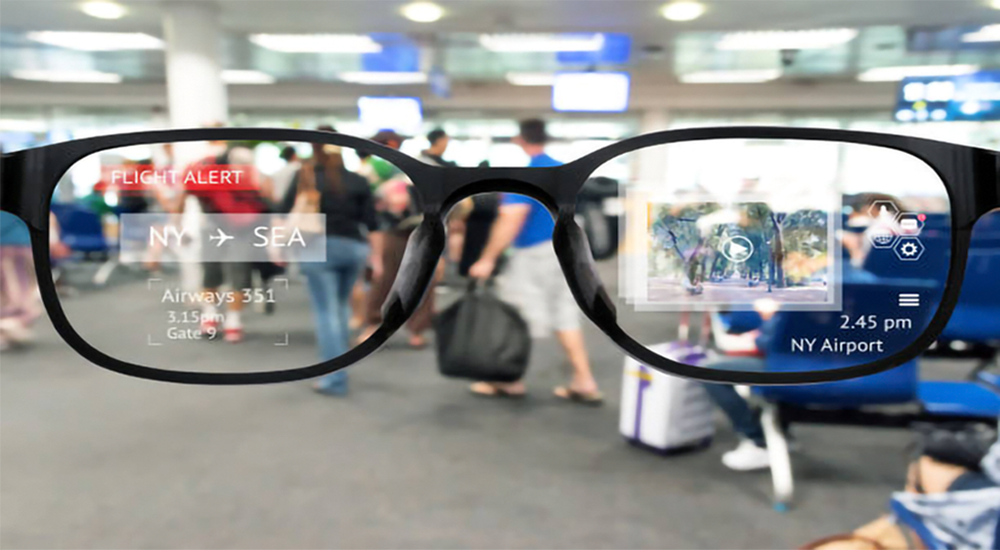March 4, 2022
| 7 min read

According to Statista, there are currently 810 million mobile AR/VR users around the world. By 2021, AR/VR companies have already sold around 410,000 AR-VR devices and the net worth of the industry stood somewhere around US$30.7 billion.
Statistica projects that by the end of 2024, the market size of the AR/VR industry will grow to almost $269.9 billion, which is a rise of a whopping 866% in just three years.
That may seem like a fairytale expansion to many but if we look at the current AR trends 2022, nothing will seem impossible. What we had just imagined a few years back is already available in the market now as a full-fledged consumer product.
The top companies like Meta and Ray-Ban are partnering to refine AR glasses. VR brands like Fortnite are hosting entirely virtual parties.
In 2022 and beyond, augmented reality is one technology that is no longer limited to science-fiction movies. Here are some of the top AR trends 2022 you should keep an eye on:

Along with the Meta-Ray-Ban AR glasses that Mark Zuckerberg advertised a few months back, Snapchat also released its Snap Glasses back in May 2021. And if the rumors are right, we might soon see Apple AR Glasses sometime in 2022 that should make both the product and technology mainstream soon.
With AR glasses in the consumer market, you can expect more and more businesses to build for AR soon. You can window shop with your AR glasses on and scan barcodes of merchandise, then and there, to get the full product description without any help from any sales executive.
Similarly, you can use your AR glasses to search for the best local restaurants, compare menus, read online reviews, and more.
And if all that seemed intriguing, by 2025, we should have AR contact lenses as a California-based startup called Mojo Vision has already displayed a prototype in a press conference.
Smaller AR glasses are the next step to making augmented reality growth more fast-paced that is indeed where the world is headed starting in 2022.

Remember how you tend to feel lost in massive supermarkets, shopping malls, hospitals, and sports stadiums? And how the signs are not always reliable?
Soon, you should be replacing that ordeal with AR-enabled indoor navigation, where you can either use your AR glasses or smartphones to find places, stores, departments, and seats.
5G is already on the rise and our devices should become leaner and smarter. More and more smartphones will start having better AR functionalities with LiDAR technology and 3D mapping. Apple’s iPhone 12 already makes AR look realistic by adding depth and object recognition to the projected images that should pave the way for more realistic AR navigation.
For example, you enter the supermarket and target your phone’s camera to the space in front of you.
All the information you require will start popping out from behind the shelves. Some years down the line, each piece of information will have depth according to the shelve placement. You will not see a cluttered 2D image that tends to make comprehension difficult.
Yes, the virtual try-out technology is no longer an Augmented Reality 2022 trend, but the omnichannel version is sure to take the market by storm.
The ongoing pandemic has changed the dynamic of both online and offline shopping and a hands-free experience is now a more desired feature in the overall customer experience. Previously, virtual try-outs were only restricted to social media filters. Now, brands are slowly investing in webAR, mobile AR, and in-store AR.
GAP in the United States popularized in-store virtual try-outs. You can simply walk into a physical store, try on multiple outfits from GAP’s digital catalog on your live feed, and order the one you like without ever touching any merchandise.
Tanishq did something similar with its jewelry in India but the brand’s virtual try-and-buy option is more omnichannel with mirrAR’s augmented reality solutions. You can virtually try Tanishq’s jewelry in their stores, website, mobile app, and even in advertisement kiosks. Taco Bell, for example, is marketing heavily with taco-shaped AR filters.
It is thus no news that more and more brands will join the omnichannel augmented reality trends 2022. AR-enabled shopping experiences already help consumers make better purchase decisions and enterprises around the world should embrace virtual try-outs to further their online shopping ventures.
.png)
You have surely heard all the buzz around self-driven cars. And you must have seen the advertisements of futuristic vehicles with AR-enabled windscreens.
In 2022 and beyond, the trend of smart autonomous vehicles should become a reality where you can voice command your vehicles to drive to a particular restaurant, all the while reading the menu on the windscreen of your car.
Another ten years and you can set the weather that you view through the windows, collect information about newly open stores, intelligently find empty parking spaces, or drive directly to where your other friends are dining.
Augmented reality and virtual reality 2022 trends seem to be the strongest in the upcoming automotive sector. As the drivers and the passengers become free, making the ride more immersive and enjoyable is the target of automakers.
Fast-forward to 2030 or even 2040 and you might even have your own in-car AR personal assistant that can take care of all your chores while you stream the movie you enjoy as your car drives.
However, a fully-functioning autonomous car might still be a distant reality given the complexity of the technology. But you can expect AR to pop up on your windscreen to help you navigate better, find local stores, drive more consciously, and keep a tab on your car’s vitals.
The fact that Meta promised this technology in 2021 has already made holograms one of the top AR trends 2022.
In a short video, Mark Zuckerberg showed how you could attend a concert with your friend, taking place millions of miles away, as a hologram. You can see your friend and your friend can see you, but you are actually still sitting on your couch and have not moved an inch.
Holograms are certainly the next level of augmented reality. And that is surely how augmented reality technology will look like either in 2030 or 2040.
As of now, brands like Ted Talks have already started using life-size holograms of actual people to deliver talks on stage. No longer do speakers have to travel around the world to deliver a talk. They can be in their rooms in front of the appropriate cameras while their holograms can stand on the Ted stage.
Meta’s idea of holograms should take some time to design. A hologram that can move in real-time and interact with the person beside is still a futuristic technology. But the reason why we should bother about it living in 2022 is that along with Meta, other big companies like Microsoft are dreaming ambitiously along these lines. Microsoft is looking to make its Team Meetings more interactive and holograms are surely the way to do it.
Following the pandemic, the healthcare system should see considerable investments, and if augmented reality is the next upcoming technology, the fit is naturally perfect.
Healthcare professionals are already using AR to keep track of their days and organize their workload, and going forward, doctors should start using augmented and virtual reality to simulate complicated surgeries and plan such medical care better.
With AR glasses in the picture, medical students can revisit the different organs and body parts during live surgeries. Healthcare support staff can access information about patient care from a central database and offer more personalized treatment.
Doctors can also recommend medicines better as the chemical components of each drug comes up every time an AR glass scans a drug bottle.
AR-enabled simulations have similar applications in the military, education, emergency services, and much more. And big and small companies alike are already developing AR programs to enable professionals to serve the people better.
Do not be surprised if, in a few years’ time, your hired handyman can fix even more items just because their AR glasses run a live tutorial as they work on a specific item.
If you have played Pokemon Go, you know that the game uses AR technology to superimpose Pokemons on a real video. But what if you could pat your Pokemons, feel their presence, and get the full experience as a trainer?
Full-body haptic suits can make that possible. And companies like TESLASUIT are promising “feel” not only in the augmented reality space but in virtual reality as well.
The idea is to send out adequate vibrations so that you can touch and feel virtual objects. Right now, we have haptic gloves that give us the sensation of touch just on our palms in the digital world. Full-body suits will naturally revolutionize the gaming sector first and then gradually find their way into healthcare and military simulations.
Combine this technology with holograms and you have a futuristic way of communication as well. You can not only have in-person business conversions with people sitting on opposite ends of the world but also shake their hands and pat their back. Things might seem too fictional for now but nothing is impossible anymore in the AR/VR space.
Just fill out the form and we’ll get back to you within 24 hours!
